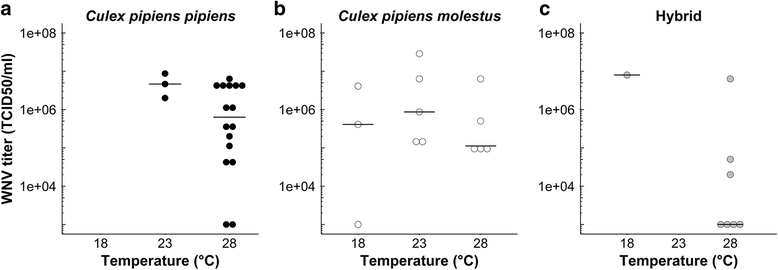Vector competence of northern European Culex pipiens biotypes and hybrids for West Nile virus is differentially affected by temperature
- PMID: 27388451
- PMCID: PMC4937539
- DOI: 10.1186/s13071-016-1677-0
Vector competence of northern European Culex pipiens biotypes and hybrids for West Nile virus is differentially affected by temperature
Abstract
Background: Outbreaks of West Nile virus (WNV) have not occurred in northern Europe despite nearby circulation of WNV in the southern part of the continent. The main vector for WNV, the mosquito Culex (Cx.) pipiens, consists of two behaviorally distinct biotypes, pipiens and molestus, which can form hybrids. Although temperature has been shown to influence vector competence of Cx. pipiens for WNV and biotypes are differentially susceptible towards infection, the interaction between the two has not been elucidated.
Methods: We determined vector competence of the Cx. pipiens biotypes and hybrids, after 14 days of incubation at 18, 23 and 28 °C. Mosquitoes were orally infected by providing an infectious blood meal or by injecting WNV directly in the thorax. Infection and transmission rates were determined by testing the bodies and saliva for WNV presence. In addition, titers of mosquitoes with WNV-positive bodies and saliva samples were determined.
Results: Orally infected biotype pipiens and hybrids showed significantly increased transmission rates with higher temperatures, up to 32 and 14 %, respectively. In contrast, the molestus biotype had an overall transmission rate of 10 %, which did not increase with temperature. All mosquitoes that were infected via WNV injections had (close to) 100 % infection and transmission rates, suggesting an important role of the mosquito midgut barrier. We found no effect of increasing temperature on viral titers.
Conclusions: Temperature differentially affected vector competence of the Cx. pipiens biotypes. This shows the importance of accounting for biotype-by-temperature interactions, which influence the outcomes of vector competence studies. Vector competence studies with Cx. pipiens mosquitoes differentiated to the biotype level are essential for proper WNV risk assessments.
Keywords: Arbovirus; Culex; Infection; Temperature; Vector competence; West Nile virus.
Figures



References
-
- Fros JJ, Geertsema C, Vogels CB, Roosjen PP, Failloux AB, Vlak JM, et al. West Nile virus: High transmission rate in north-western European mosquitoes indicates its epidemic potential and warrants increased surveillance. PLoS Negl Trop Dis. 2015;9(7) doi: 10.1371/journal.pntd.0003956. - DOI - PMC - PubMed
Publication types
MeSH terms
LinkOut - more resources
Full Text Sources
Other Literature Sources

